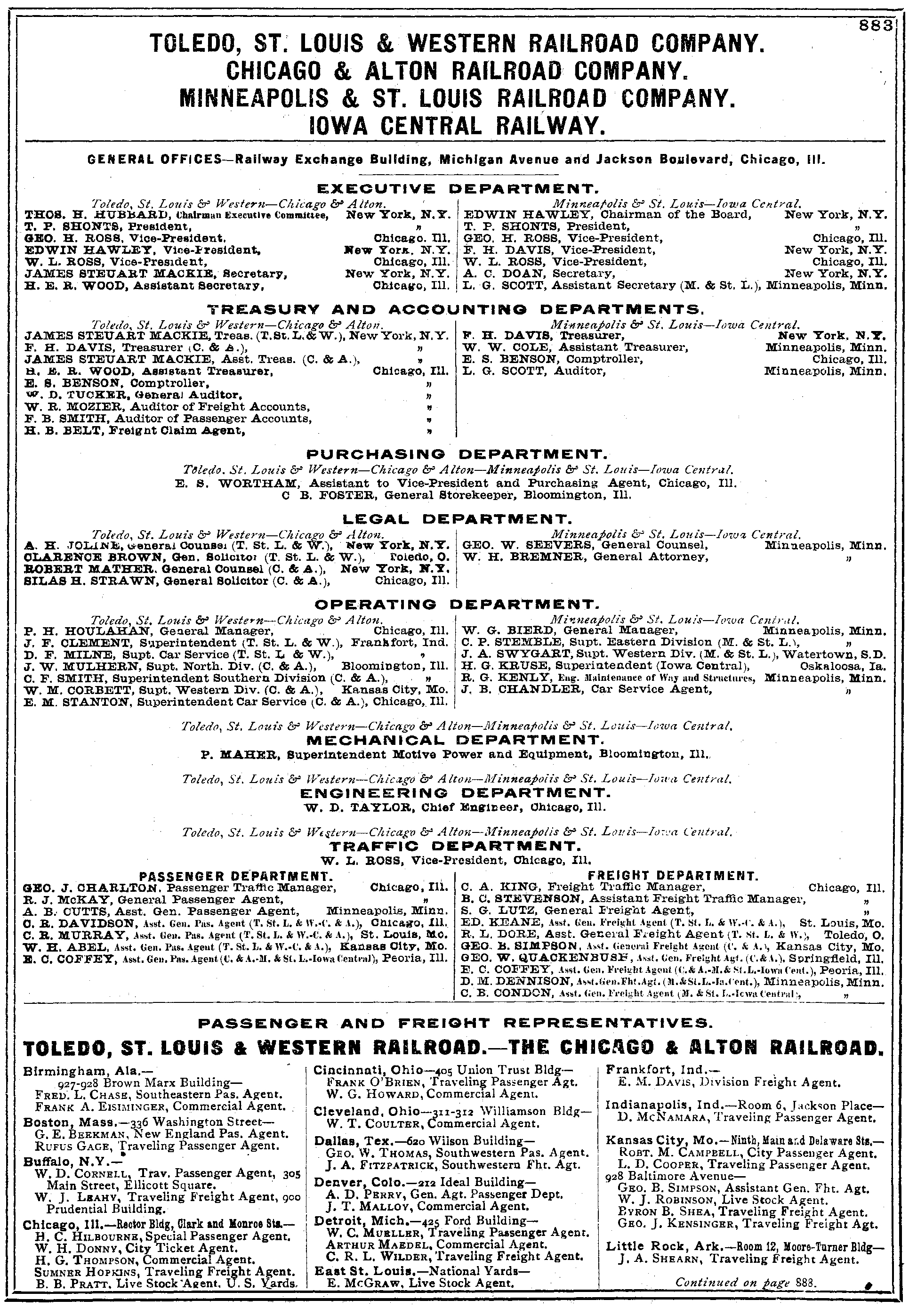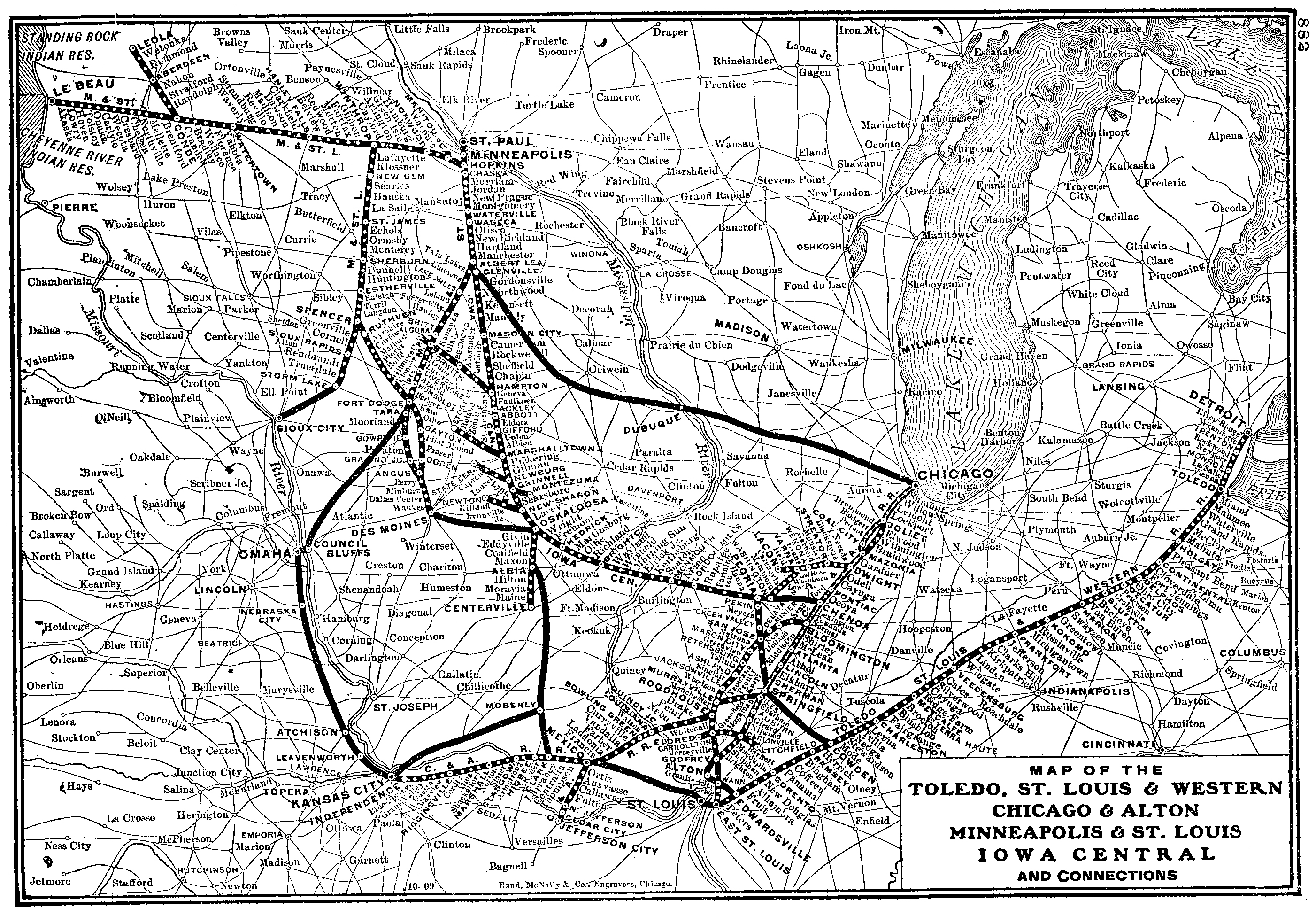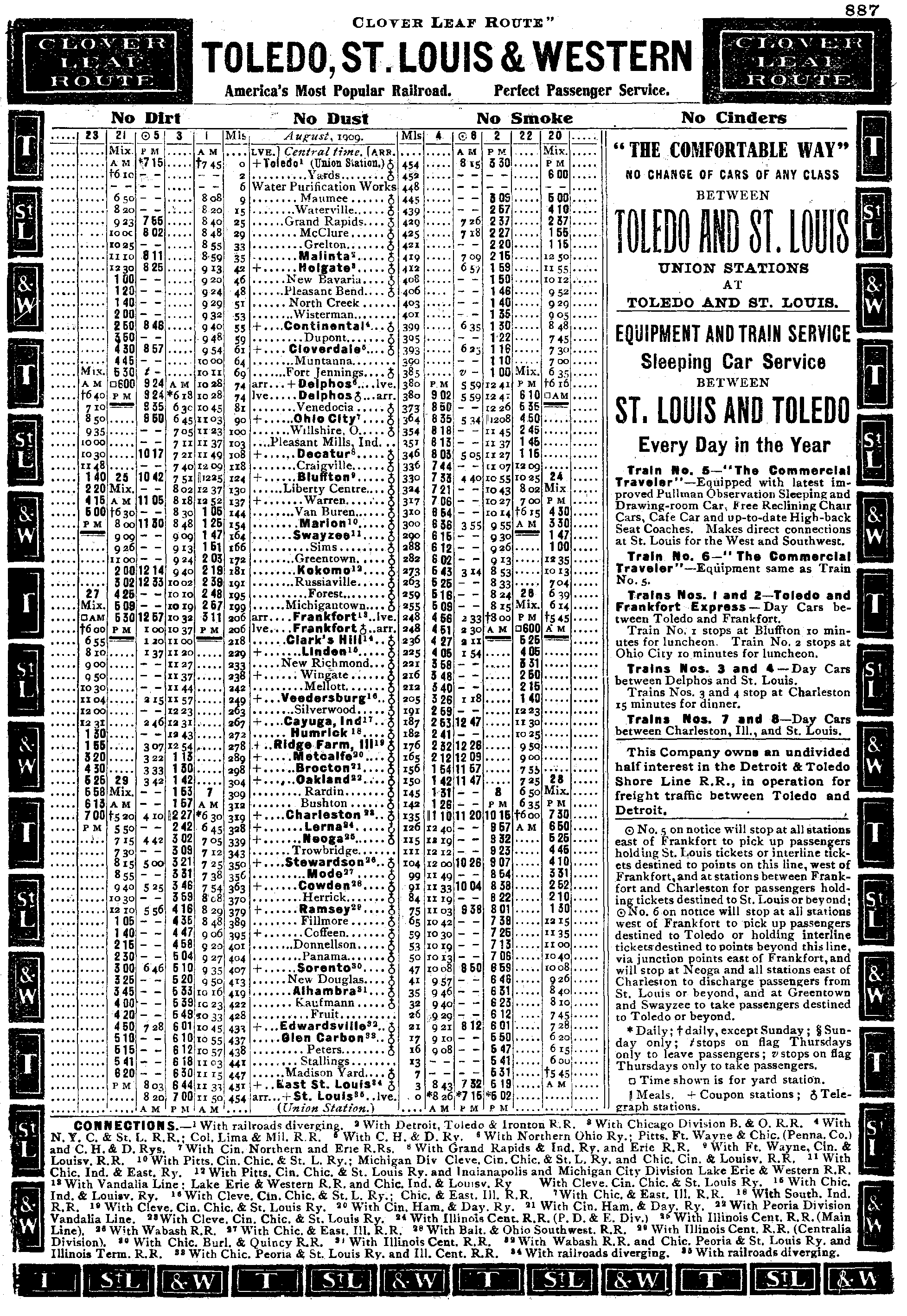Toledo, St. Louis and Western Railroad: Map, Timetables, History
Last revised: August 23, 2024
By: Adam Burns
The Toledo, St. Louis and Western Railroad, also known as the Clover Leaf Route, operated in the midwestern United States from 1881 to 1922. It ran from Toledo, Ohio, through Indiana and Illinois to East St. Louis, Illinois.
The railroad was primarily used for freight services, but also offered passenger services. In late 1922, it was absorbed into the New York, Chicago and St. Louis Railroad, commonly known as the Nickel Plate Road.
History
The history of the Toledo, St. Louis & Western Railroad (TStL&W), fondly known as the "Clover Leaf Route," is deeply interwoven with the development and evolution of the American transportation system in the late 19th and early 20th centuries.
The TStL&W started its operations in the late 1800s, traversing the Midwestern United States to connect the important industrial and agricultural regions of that era.
The roots of TStL&W could be traced back to its predecessor railroads. Its earliest predecessor was the narrow-gauge Toledo & Maumee, when opened a seven-mile line along the Miami & Erie Canal in Toledo, Ohio in 1874.
Following the consolidation of several other narrow-gauge systems, the Toledo, Cincinnati & St. Louis Railroad (TC&StL) was formed in February, 1881, which had reached East St. Louis in 1882.
The TC&StL had an ambitious plan to unite Toledo, Ohio; East St. Louis, Illinois; and Cincinnati, Ohio. Facing financial difficulties, it broke into smaller companies by 1883, losing its Cincinnati corridor in the process.
The remaining Toledo - East St. Louis line was reincorporated as the Toledo, St. Louis & Kansas City Railroad on June 12,1886. In 1887 the first segment from Toledo to Frankfort, Indiana was standard-gauged followed by the Frankfort-St. Louis segment in 1889.
After facing bankruptcy, the TStL&K was reorganized as the Toledo, St. Louis & Western Railroad (TStL&W) in 1900. The TStL&W extended its services across the key agricultural and industrial states of the Midwest. The main line extended from Toledo, Ohio, to East St. Louis, Illinois, linking several crucial market towns and farming regions.
It's worth noting that the TStL&W covered an approximate mileage of 451 miles. This vital stretch had significant implications for trade and transportation during the time of its operation, and it played a pivotal role in the economic transformation of the American Midwest.
The TStL&W earned its nickname "Cloverleaf Route" from the familiar emblem painted on its boxcars, hoppers, and cabooses. The symbol, consisting of a four-leaf clover on a black background surrounded by a white circle, became synonymous with the TStL&W, differentiating its services in the competitive railroad market and adding to its unique identity.
Throughout its operational history, the Cloverleaf Route was reputed for its excellent service and ingenuity. It was one of the first railroads to implement automatic block signaling along its mainline, ensuring safer and more efficient operations. At the same time, the TStL&W also exemplified the spirit of constant innovation and improvements.
Over the years, the TStL&W expanded its services and upgraded its logistic capabilities to meet the intensifying market demands. This commitment to service improvement and customer satisfaction was pivotal in powering the growth and popularity of the Cloverleaf Route.
At A Glance
Surviving through varied economic fluctuations and the evolving demands of the American railroad industry, the TStL&W became an integral part of the region's industrial fabric. Its impact on the socio-economic growth of the Midwest is immeasurable and lasting.
However, running a competitive railroad operation also came with its share of challenges, and the TStL&W was no exception. It had to regularly innovate and upgrade its services to stay ahead and adapt to transforming market dynamics.
Nickel Plate Road
In 1922, the TStL&W lost its identity as an independent railroad. It became the Toledo Division of the New York, Chicago & St. Louis Railroad (NYC&StL), famously known as the "Nickel Plate Road," finally providing the parent company access to St. Louis.
This significant development marked the end of the TStL&W as an independent entity, while also signaling the beginning of a new chapter in its rich history.
The synergies from the merger enabled the NYC&StL to establish a cohesive service network stretching over several states, revolutionizing transportation dynamics and solidifying its stature in the American railroad industry. Meanwhile, the integration of TStL&W into the larger NYC&StL network marked a significant milestone in the history of the Cloverleaf Route.
System Map (1910)
Post-merger, the TStL&W routes continued to support the expanded network. The railroad lines adapted and thrived, contributing to the NYC&StL's pan-regional operations. This blending of operations marked the perpetuation of the TStL&W's legacy, albeit under a different flagship.
Even after its merger, the TStL&W continued to operate under its renowned nickname, "Cloverleaf Route". The familiar cloverleaf icon remained, albeit subtly, a part of the larger NYC&StL visual identity.
Throughout its existence, TStL&W was synonymous with constant evolution, adaptability, and resilience. The rail line survived market dynamics, economic upheavals, and competition while striving to provide the best service to its passengers and freight customers. This approach and dedication were cornerstone principles inherited by its successor, the NYC&StL.
The TStL&W emphasized technological advancements and modernization throughout its operational history. This commitment to progress and innovation made it an attractive asset for the NYC&StL, contributing to its decision to acquire the TStL&W.
The legacy of the TStL&W transcends its operational timeline. Its contributions to the socio-economic growth of the Midwest, emphasis on constant modernization, and commitment to safety and quality service left an unmistakable imprint on the American railroad landscape.
Today
Today, much of the original Cloverleaf Route is still in operation under the Norfolk Southern Railway, the present-day successor to the NYC&StL. The continuity of these railway lines is a testament to the pivotal role played by TStL&W in shaping the American Midwest's transportation infrastructure.
Remnants of the TStL&W’s physical infrastructure still pepper the landscape across its former operating regions, from sturdy rail bridges to the original Toledo Division offices. These relics remind us of the railroad's footprint and its significance in an era gone by.
Undoubtedly, the history of the TStL&W is more than just about the railroad operations. Examining its heritage reveals the political, economic, and social transformations that unfolded across the Midwest during the late 19th and early 20th centuries. The TStL&W was both a participant in and a catalyst for these significant evolutionary stages.
The TStL&W's story is also marked by persevering ingenuity, resilience, and adaptability. It reflects the challenges and opportunities presented by industrialization, market competition, and economic uncertainty, drawing a compelling picture of survival and growth.
The TStL&W's saga is filled with lessons about the value of adaptability, innovation, and resilience for modern businesses and organizations. Adapting to economic flux, embracing technology, seizing growth opportunities, and valuing customer satisfaction are enduring principles applicable across industries and timeframes.
The TStL&W story inspires reflections on the role of transportation and logistics as economic catalysts. It illuminated the impact of an efficient and reliable transportation network on regional growth, facilitating the movement of goods and people across significant distances and diversities.
The legacy of the TStL&W also provides insights into the complex dynamics of mergers and acquisitions within the railroad industry. The merger with the NYC&StL illustrated both the complexities involved and the potential benefits of such strategic decisions, offering food for thought for scholars and enthusiasts.
While the TStL&W as an independent entity ceased after the merger with NYC&StL, its unique operating principles, commitment to innovation, and service-oriented ethos have lived on, influencing successive rail operators and shaping the unfolding narrative of American railroads.
The evolution of its routes under the NYC&StL and now the Norfolk Southern Railway also offers illuminating perspectives on the dynamic nature of transportation infrastructure. It showcases the need for adaptability, technological progress, and strategic growth for lasting success.
The TStL&W’s nickname, the Cloverleaf Route, encapsulates more than merely its recognizable icon. It reflects the railroad’s resilient spirit, it's intertwining with the American Midwest’s socio-economic profile, and its impression in the collective consciousness of the region's populations.
Timetables (1910)
Synonymous with the cloverleaf are themes of industriousness, prosperity, and luck, which resonate with the spirit of the TStL&W’s operational philosophy. Even today, these themes echo through the landscapes and towns once served by the Cloverleaf Route.
Though the TStL&W ceased operations nearly a century ago, its tale continues to engage students, scholars, and railroad enthusiasts. The rich history, pioneering technologies, unprecedented growth, and significant regional contributions allow the Cloverleaf Route to continue as a subject of great interest and engagement.
Looking ahead, the TStL&W's tale offers valuable lessons for future transformations in the transportation sector. As we grapple with the sustainability challenges of modern transportation, the history of the Cloverleaf Route reminds us to cherish the legacy of past transportation modes and think prudently about our future directions.
In the grand tapestry of American railroad history, the TStL&W— the Cloverleaf Route— stands as a vibrant thread. Its tale spans many critical years in our nation's past, characterized by growth, innovation, competition, collaboration, and transformation impacting the lives of countless individuals and communities.
Far more than mere steel and steam, the Toledo, St. Louis & Western represents a pioneering spirit, an era of growth and exploration, and most lastingly, the power of transportation to bind together communities and economic potentials.
Conclusion
In conclusion, the Toledo, St. Louis & Western Railroad, popularly known as the Cloverleaf Route, has left an indelible mark on the American railroad landscape.
Its historic journey, from its inception to its merger with the NYC&StL, and its lasting impact on the Midwestern United States marks it as a unique chapter in the American railway story.
It's a legacy that persists, influencing the strategies and operational tenets of the present-day transportation infrastructure across the United States.
Recent Articles
-
Ohio - Whiskey - Train Rides
Dec 24, 25 05:47 PM
Ohio, with its rich history and scenic landscapes, offers an unusual yet delightful experience for spirit enthusiasts and travel aficionados alike: whiskey train rides. -
California Thomas The Train Rides
Dec 24, 25 05:44 PM
Held at various railroad museums and heritage railways across California, these events provide a unique opportunity for children and their families to engage with their favorite blue engine in real-li… -
Texas Thomas The Train Rides
Dec 24, 25 05:42 PM
In the heart of Texas, where everything is said to be bigger and bolder, lies an event that captures the imagination of children and families alike - A Day Out With Thomas.






